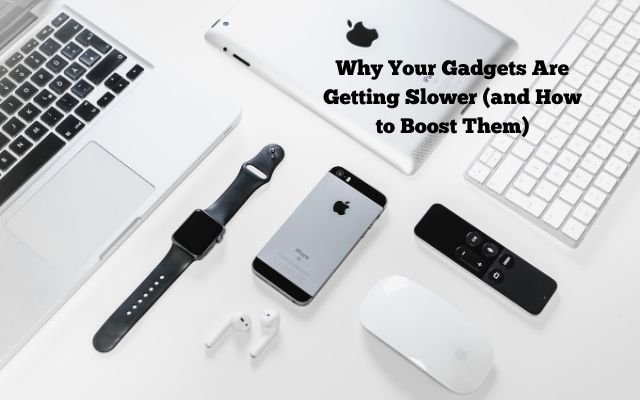Why Your Gadgets Are Getting Slower (and How to Boost Them)
Tips and Tricks for Speeding Up Your Devices

Discover why your gadgets are getting slower over time & learn simple tips to boost performance and keep them running smoothly
As gadgets like laptops or phones get older it’s common to notice that they slow down. A device that’s been with you for three years won’t perform as fast as it did when you first bought it. But why does this happen? Is it just that your device is “wearing out” over time?
The slowdown of gadgets usually isn’t caused by just one thing. There can be several factors working together, which is why one device might slow down differently than another, even if they’re the same model. The Apple battery issue was one of those rare cases where there was only one contributing factor. A gadget slowing down is usually caused by several things. Because the hardware (the actual components) and software (such programs and the system) might both be impacted, resetting your device doesn’t always solve the issue.
In some cases, you can improve performance by making certain changes but in other cases it’s just your device’s aging process. Understanding this might assist you in determining when to consider acquiring new one or when to perform better.
Software Slowdowns
As time goes on, software slowdowns are a common problem for phones, tablets and laptops. Whenever Apple, Microsoft or Google release a new update for their operating systems, they often add more advanced features. These new features may make apps more powerful, but they also demand more from your device. Unfortunately, older, less effective code may become obsolete as new features are added. This implies that in order to accomplish same things as before your phone or laptop must work harder.
Not only do operating systems get upgrades but third-party apps/apps created by other developers also receive updates. To take advantage of new hardware features and provide even more functionality, developers upgrade their programs. For example- they might have an augmented reality (AR) filter or new instant messaging function. It becomes more difficult for your device to keep up when software advances and hardware remains unchanged.
One example is iTunes which has evolved over the years by gaining more features but it’s still trying to perform the same tasks it did years ago like ripping CDs or streaming music. With every update, iTunes has become slower and less efficient, even if you’re not storing more music or media on your device. This slowdown is common with software that becomes more complex over time.
Developers begin working on apps and updates to take advantage of newly released devices with better hardware. For those who own the newest laptops or smartphones, this is fantastic but if your device is a few years old, it will have trouble keeping up with the new features and coding. Older gadgets eventually become entirely outdated.
A term known as software entropy describes this problem. Operating systems (like iOS or Android) need to leave space for apps to interact with them and the more apps and hardware that come into play, the more inefficient things become. As more apps are developed and used, inefficiencies pile up. This is why Apple’s more controlled approach to operating systems and apps can help reduce these problems.
But it’s not just software developers causing slowdowns—users like you also contribute. The more you use apps, save files, and set preferences, the more complicated the software becomes. For instance- a podcast app filled with episodes and playlists will use up more resources than it did when it was first installed. We often install more extensions on our browsers and set programs to automatically launch when we start up our device, putting even more pressure on hardware.
Running out of room for storage is another frequent problem. No device, be it a laptop, tablet or phone, functions optimally when its storage is almost full. Operating system will have less area to handle open apps and files if there is not enough free space which could cause slowdowns or even frequent failures.
Users and apps are both accountable for this. While consumers frequently fill their devices with additional images, movies & apps, some programs may not properly remove temporary data after use. Even though storage management in contemporary operating systems has improved over time, it’s still a problem particularly if your device is older.
On desktops and laptops, storage problems can also affect memory usage. Windows, for example, uses hard disk space as backup when the RAM (your device’s memory) is full, such as when you’re playing games or editing videos. If your hard disk space is low, it takes Windows longer to process all the data, causing noticeable slowdowns.
Lastly, there’s security angle. Viruses and malware can severely affect your device’s performance. They consume memory, storage and other resources, sometimes intentionally disrupting your programs. If your device’s performance has taken a sharp dive, it might be worth running a full system security scan to see if malware is the culprit.
Software slowdowns are a natural part of aging devices. Whether it’s due to new, demanding features, old hardware struggling to keep up, or user habits like filling up storage, the slowdown can often be managed to some degree but not completely avoided. Understanding these causes can help you maintain your device for as long as possible before considering an upgrade.
Hardware Slowdowns
While most of slowdowns you experience on your gadgets are due to software becoming more complex, hardware can also play a role. Over time, there is some natural wear & tear especially in components like lithium-ion batteries.
Batteries in your laptop or smartphone are designed to degrade over time—this is just part of how technology works. As your battery gets older, you’ll notice that it doesn’t last as long between charges. This doesn’t directly impact how fast your device works, but it does mean you’ll have to charge more often. That’s why manufacturers give guidelines on how to care for your battery to slow down this aging process.
In some cases, however, a failing battery can cause performance issues. For example- Apple admitted to slowing down devices with older batteries to prevent unexpected shutdowns. While apps themselves should still run at the same speed, a dying battery might lead to crashes or other problems.
Another part of our device that can cause slowdowns is mechanical hard drive (HDD). These older hard drives don’t slow down much unless they’re about to fail completely. While bugs or power outages can sometimes corrupt data on an HDD, causing your system to work harder, this usually isn’t a major factor in a system’s gradual slowdown. If your hard drive is running too hot or is being used constantly, it may fail sooner but again, it’s not a primary cause of slowdowns.
Solid-state drives (SSDs) and the flash memory found in smartphones and tablets perform differently. These storage components don’t really “slow down” over time the way mechanical hard drives might. The only time you’ll notice a slowdown with these drives is if you’re running out of storage space which we discussed earlier. Although SSDs do have a limited lifespan, they usually maintain good performance until they reach that point.
As for key components like the CPU (processor) and RAM (memory), they don’t really slow down as they age. Over time, the difference in their performance is so small that it’s practically unnoticeable during the lifetime of your device. These parts can fail, but if your computer or phone is slowing down, it’s almost never because the processor or memory is wearing out.
To keep your device running as smoothly as possible, there are a few tips you can follow. Keep as much free storage space on your gadget as you can. Install only the apps you really need and keep them up-to-date, along with your operating system. Keeping your apps lightweight and avoiding unnecessary ones can help reduce the strain on your hardware.
A full system reset or reinstalling your operating system can help, too. This process wipes away many of the issues that build up over time. However, if you’re not restoring the original OS that came with your device, it might not feel as fast as it once did, even before you reinstall your apps.
- How Spotify Keeps Me Productive Throughout My Day
- Watch Restricted YouTube Videos Without Login
- Choosing a Smart Home Brand: 6 Factors to Consider
In the end, unless you use your device in a perfectly pristine state—without installing new apps, updates, or files—some slowing down is unavoidable as it ages. But following these tips can help minimize it and keep your device running as smoothly as possible for as long as it can.



